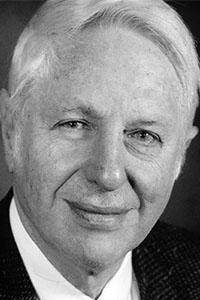Paul Martin
Paul Martin was appointed Dean of the then Division of Engineering and Applied Physics in January 1977.
Under Martin's leadership, research and educational programs in materials science and engineering, in computer science and engineering, and in the atmospheric and environmental sciences have reached new levels, and Harvard's historic commitment to engineering were renewed.
The growth of undergraduate interest in engineering and applied science and the increasing importance of these disciplines in the Faculty were reflected in the FAS Academic Plan in 1992, which called for significant additions of faculty and facilities.
A major step toward these goals was taken with the $25 million gift from Bill Gates and Steve Ballmer (both Class of '77), which made possible the construction Maxwell Dworkin, a building for computer science and electrical engineering.
Martin, who holds bachelor's and Ph.D. degrees from Harvard, joined the faculty in 1957 and was promoted to professor of physics in 1964.
In 1982 he became the first occupant of the Van Vleck chair, named for one of Harvard's most distinguished physicists. Martin's primary work has been in the area of condensed matter theory.
Top Shelf
The top shelf of Paul Martin’s bookshelf is reserved for the dissertations of his graduate students, many of whom, he proudly tells, have made significant contributions to the field of theoretical physics.
Recounting his career at Harvard, where he has been “forever,” Martin, the former dean of the then Division of Engineering and Applied Sciences, is more comfortable talking about his past students’ accomplishments than his own.
Martin joined the faculty in 1957 and worked closely with graduate students for the next two decades. “I was fortunate to have unusually gifted students at a time when we had lots of interesting problems for them to tackle,” he says.
He and his students had countless discussions and scratched innumerable equations on blackboards, many in the same Lyman Laboratory office where the dissertation-adorned bookshelf now resides.
They introduced methods now widely used in statistical and condensed matter physics and used them to study the properties of magnetic systems, superconductors, superfluids, and the general features of phase transitions, chaos, and turbulence. Following in the footsteps of his two predecessors, theoretical physicists John Van Vleck and Harvey Brooks, Martin became dean of the Division in 1977.
Philosophical Issues and Dynamic Systems
At the time, the Division of Engineering and Applied Physics was facing some financial (and philosophical) issues. The faculty had voted to change the name to the Division of Applied Sciences, suggesting a commitment to engineering was ambivalent at best.
“The steadfast contributions of a few faculty, including Fred Abernathy and Vic Jones, were critical in reversing this trend,” says Martin. Under Martin’s leadership, the Division recruited key faculty—especially in computer science, material sciences, and atmospheric sciences. During his deanship the construction of the hallmark Maxwell-Dworkin building was begun.
By serving concurrently as an Associate Dean, he worked closely with three deans of the Faculty of Arts and Sciences on science planning, research, and research policy to help strengthen connections between disciplines.
“The Division has traditionally been the hub of multidisciplinary research activities in the Faculty of Arts and Sciences and of joint programs with Harvard’s other Schools,” he explained.
“We also were the home of two major programs across New England—the New England Consortium for Undergraduate Science Education, which sponsored and nurtured projects and programs at 12 New England colleges and four universities, and the northeastern home of the National Institute for Global Environmental Change.”
In recent years Martin has enjoyed teaching graduate students again, in the areas of dynamical systems, electromagnetic theory, many-body theory, and solid-state physics.
As he takes on the next phase of his academic career, Martin will leave the office that holds decades of memories of academic discovery to move one floor up, “closer to heaven” —but still grounded at Harvard.
